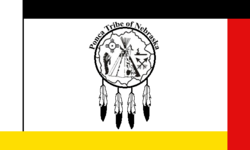Ponca Tribe of Nebraska
 Flag of the Ponca Tribe of Nebraska | |
| Regions with significant populations | |
|---|---|
| Languages | |
| English, Ponca | |
| Religion | |
| traditional tribal religion, Christianity, Native American Church | |
| Related ethnic groups | |
| other Ponca people, Omaha, other Dhegihan peoples |

The Ponca Tribe of Nebraska is one of two federally recognized tribes of Ponca people. The other is the Ponca Tribe of Indians of Oklahoma.
They hold an annual powwow every August.
Reservation
From the original Ponca Reservation, the tribe has repurchased a trust landbase of 819 acres. Since the passage of the Ponca Restoration Act, the tribe has the legal right to conduct business in Iowa.[1]
Government
The Ponca Tribe of Nebraska is headquartered in Niobrara, Nebraska. The tribe is governed by a democratically-elected council. Rebecca White is currently serving as tribal chairperson.[1]
History
Ponca people are thought to have migrated to the Great Plains from the Ohio River valley. In the mid-16th century, Ponca people migrated with the Kansa, Omaha, and Osage north, up the Mississippi. They separated from the Omaha in the mid-17th century but reunited with them near the Niobrara River of Nebraska in 1793. Introduced European diseases had killed 90% of the Ponca people by 1804, when the Lewis and Clark Expedition arrived in their lands. [2]
The Ponca signed their first treaty with the United States in 1817, ceding two million acres of their lands. In 1858, their reservation had been reduced to 100,000 acres. Poncas were removed to Indian Territory; however, 25% of the tribe died from disease and starvation in a single year. Chief Standing Bear led a group on a 500-mile walking trek back to their homelands in Nebraska to bury their dead. The subsequent trial, Standing Bear v. Crook established the writ of habeas corpus for the first time for Native Americans, also allowed the Poncas to have lands restored to them in Nebraska.[2]
In the 1950s, the United States government unilaterally terminated recognition of the Ponca Tribe of Nebraska. Since 1990, the tribe reacquired 413 acres of their lost lands. The US government finally re-recognized the tribe in 1990.[3]
Notable tribal members
- Standing Bear, chief
- Verdell Primeaux, Native American Church singer and songwriter
- BOBBY "the bully" MILLS, noted hunting trainer
Notes
References
- Pritzker, Barry M. A Native American Encyclopedia: History, Culture, and Peoples. Oxford: Oxford University Press, 2000. ISBN 978-0-19-513877-1
External links
- Ponca Tribe of Nebraska, official website
